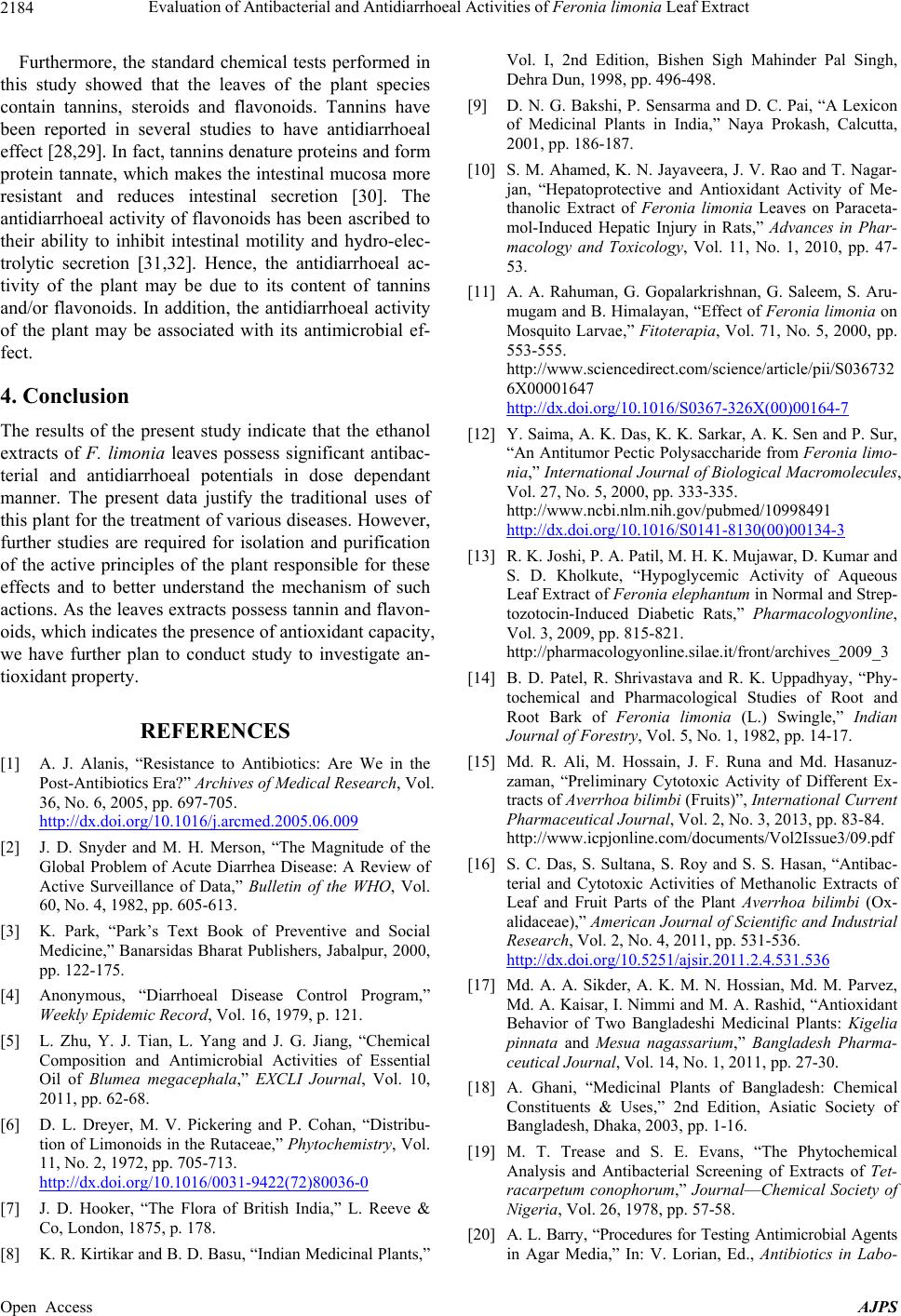
Evaluation of Antibacterial and Antidiarrhoeal Activities of Feronia limonia Leaf Extract
2184
Furthermore, the standard chemical tests performed in
this study showed that the leaves of the plant species
contain tannins, steroids and flavonoids. Tannins have
been reported in several studies to have antidiarrhoeal
effect [28,29]. In fact, tannins denature proteins and form
protein tannate, which makes the intestinal mucosa more
resistant and reduces intestinal secretion [30]. The
antidiarrhoeal activity of flavonoids has been ascribed to
their ability to inhibit intestinal motility and hydro-elec-
trolytic secretion [31,32]. Hence, the antidiarrhoeal ac-
tivity of the plant may be due to its content of tannins
and/or flavonoids. In addition, the antidiarrhoeal activity
of the plant may be associated with its antimicrobial ef-
fect.
4. Conclusion
The results of the present study indicate that the ethanol
extracts of F. limonia leaves possess significant antibac-
terial and antidiarrhoeal potentials in dose dependant
manner. The present data justify the traditional uses of
this plant for the treatment of various diseases. However,
further studies are required for isolation and purification
of the active principles of the plant responsible for these
effects and to better understand the mechanism of such
actions. As the leaves extracts possess tannin and flavon-
oids, which indicates the presence of antioxidant capacity,
we have further plan to conduct study to investigate an-
tioxidant property.
REFERENCES
[1] A. J. Alanis, “Resistance to Antibiotics: Are We in the
Post-Antibiotics Era?” Archives of Medical Research, Vol.
36, No. 6, 2005, pp. 697-705.
http://dx.doi.org/10.1016/j.arcmed.2005.06.009
[2] J. D. Snyder and M. H. Merson, “The Magnitude of the
Global Problem of Acute Diarrhea Disease: A Review of
Active Surveillance of Data,” Bulletin of the WHO, Vol.
60, No. 4, 1982, pp. 605-613.
[3] K. Park, “Park’s Text Book of Preventive and Social
Medicine,” Banarsidas Bharat Publishers, Jabalpur, 2000,
pp. 122-175.
[4] Anonymous, “Diarrhoeal Disease Control Program,”
Weekly Epidemic Record, Vol. 16, 1979, p. 121.
[5] L. Zhu, Y. J. Tian, L. Yang and J. G. Jiang, “Chemical
Composition and Antimicrobial Activities of Essential
Oil of Blumea megacephala,” EXCLI Journal, Vol. 10,
2011, pp. 62-68.
[6] D. L. Dreyer, M. V. Pickering and P. Cohan, “Distribu-
tion of Limonoids in the Rutaceae,” Phytochemistry, Vol.
11, No. 2, 1972, pp. 705-713.
http://dx.doi.org/10.1016/0031-9422(72)80036-0
[7] J. D. Hooker, “The Flora of British India,” L. Reeve &
Co, London, 1875, p. 178.
[8] K. R. Kirtikar and B. D. Basu, “Indian Medicinal Plants,”
Vol. I, 2nd Edition, Bishen Sigh Mahinder Pal Singh,
Dehra Dun, 1998, pp. 496-498.
[9] D. N. G. Bakshi, P. Sensarma and D. C. Pai, “A Lexicon
of Medicinal Plants in India,” Naya Prokash, Calcutta,
2001, pp. 186-187.
[10] S. M. Ahamed, K. N. Jayaveera, J. V. Rao and T. Nagar-
jan, “Hepatoprotective and Antioxidant Activity of Me-
thanolic Extract of Feronia limonia Leaves on Paraceta-
mol-Induced Hepatic Injury in Rats,” Advances in Phar-
macology and Toxicology, Vol. 11, No. 1, 2010, pp. 47-
53.
[11] A. A. Rahuman, G. Gopalarkrishnan, G. Saleem, S. Aru-
mugam and B. Himalayan, “Effect of Feronia limonia on
Mosquito Larvae,” Fitoterapia, Vol. 71, No. 5, 2000, pp.
553-555.
http://www.sciencedirect.com/science/article/pii/S036732
6X00001647
http://dx.doi.org/10.1016/S0367-326X(00)00164-7
[12] Y. Saima, A. K. Das, K. K. Sarkar, A. K. Sen and P. Sur,
“An Antitumor Pectic Polysaccharide from Feronia limo-
nia,” International Journal of Biological Macromolecules,
Vol. 27, No. 5, 2000, pp. 333-335.
http://www.ncbi.nlm.nih.gov/pubmed/10998491
http://dx.doi.org/10.1016/S0141-8130(00)00134-3
[13] R. K. Joshi, P. A. Patil, M. H. K. Mujawar, D. Kumar and
S. D. Kholkute, “Hypoglycemic Activity of Aqueous
Leaf Extract of Feronia elephantum in Normal and Strep-
tozotocin-Induced Diabetic Rats,” Pharmacologyonline,
Vol. 3, 2009, pp. 815-821.
http://pharmacologyonline.silae.it/front/archives_2009_3
[14] B. D. Patel, R. Shrivastava and R. K. Uppadhyay, “Phy-
tochemical and Pharmacological Studies of Root and
Root Bark of Feronia limonia (L.) Swingle,” Indian
Journal of Forestry, Vol. 5, No. 1, 1982, pp. 14-17.
[15] Md. R. Ali, M. Hossain, J. F. Runa and Md. Hasanuz-
zaman, “Preliminary Cytotoxic Activity of Different Ex-
tracts of Averrhoa bilimbi (Fruits)”, International Current
Pharmaceutical Journal, Vol. 2, No. 3, 2013, pp. 83-84.
http://www.icpjonline.com/documents/Vol2Issue3/09.pdf
[16] S. C. Das, S. Sultana, S. Roy and S. S. Hasan, “Antibac-
terial and Cytotoxic Activities of Methanolic Extracts of
Leaf and Fruit Parts of the Plant Averrhoa bilimbi (Ox-
alidaceae),” American Journal of Scientific and Industrial
Research, Vol. 2, No. 4, 2011, pp. 531-536.
http://dx.doi.org/10.5251/ajsir.2011.2.4.531.536
[17] Md. A. A. Sikder, A. K. M. N. Hossian, Md. M. Parvez,
Md. A. Kaisar, I. Nimmi and M. A. Rashid, “Antioxidant
Behavior of Two Bangladeshi Medicinal Plants: Kigelia
pinnata and Mesua nagassarium,” Bangladesh Pharma-
ceutical Journal, Vol. 14, No. 1, 2011, pp. 27-30.
[18] A. Ghani, “Medicinal Plants of Bangladesh: Chemical
Constituents & Uses,” 2nd Edition, Asiatic Society of
Bangladesh, Dhaka, 2003, pp. 1-16.
[19] M. T. Trease and S. E. Evans, “The Phytochemical
Analysis and Antibacterial Screening of Extracts of Tet-
racarpetum conophorum,” Journal—Chemical Society of
Nigeria, Vol. 26, 1978, pp. 57-58.
[20] A. L. Barry, “Procedures for Testing Antimicrobial Agents
in Agar Media,” In: V. Lorian, Ed., Antibiotics in Labo-
Open Access AJPS